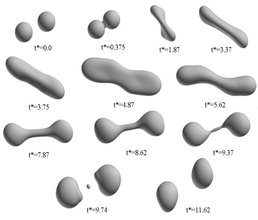Laser-Induced Forward Transfer Nano-Printing Process - Multiscale Modelling, Experimental Validation and Optimization
- Homepage
- http://gow.epsrc.ac.uk/ViewGrant.aspx?GrantRef=EP/I012605/1
- Started
- 5th January 2011
- Ended
- 4th January 2014
- Investigators
- Kai Luo, Rob Eason
LIFT is a direct-write microfabrication and micro/nano printing technique that has received much attention in the research communities and industries in recent years. It offers significant advantages over other competing printing methodologies and has potential applications in many high-tech high-value industries. However, questions remain regarding how to select a small set of experimentally controllable parameters to produce the finest, the most uniform, the most desirable single printed feature and print arrays. Despite the extensive and expensive experiments carried out by the applicants and other groups around the world, fundamental understanding of the phenomena involved in LIFT is lacking. This is attributed to the limited spatial and temporal resolutions in experiments and to the fact that many quantities/properties are not directly measurable especially at nanoscales. Crucially, the causal relationships among the various parameters are difficult to establish without an exhaustive number of expensive experiments. Therefore, it is highly desirable to develop theoretical and/or numerical models to capture the essential physics in LIFT so that trends can be predicted more easily and LIFT design more grounded on fundamental physics. Success here will revolutionise key industries that have photonics, plasmonics and microelectronics as their cornerstone.
Conventional macroscopic modelling methods do not directly lend the solution to the LIFT problem, due to the truly multiscale and multiphysics features of LIFT. The most promising approach for LIFT is the LBM, which can be viewed as a coarse-grained molecular dynamics approach, albeit with very different numerical algorithms and affordable computational expenses for real-world problems. LBM preserves the microscopic kinetic principles while recovering the full Navier-Stokes equations at the macroscales. Therefore, LBM bridges the microscales and macroscales, which makes it a valuable method for multiscale problems like LIFT. Here, we propose the very first multiscale modelling study of LIFT, supported by existing and further experimental measurements conducted at the state-of-the-art FASTlab facilities in Southampton. This is built upon the recent successes of ours and other researchers in simulating some isolated sub-processes relevant to LIFT using LBM. The novelty and significance of the proposed multiscale LBM approach is its ability to simulate the complete LIFT process including donor material melting, molten droplet formation, droplet growth, transfer, and deposition processes. The model development will proceed in a systematic manner in order of increasing sophistication. First, an isothermal multiphase LBM model will be employed to isolate the multiphase flow dynamics effects from the thermal effects. Then a thermal multiphase LBM will be tested for LIFT processes to determine the capabilities and limitations of the current (pure) LBM methodologies. The focus, however, is to develop a new multiscale LBM approach to study laser heating, donor material melting, heat conduction, thermal expansion and re-solidification. Such a multiscale approach couples LBM seamlessly with a macroscopic Navier-Stokes solver, taking advantage of each method's scale-resolving capability and numerical efficiency in different ranges of the Reynolds and Knudsen numbers. Finally, Marangoni effects will be investigated by incorporating temperature-dependent surface tension into the LBM modelling. The Marangoni effects are believed to affect the final morphology of the printed features but have not been studied in detail before. Throughout the project, the modelling and experimental teams as well as our academic and industrial partners will work closely with each other to ensure timely exchange of ideas, data and information. The final phase is to create the finest optimized features of a single printed dot and print arrays following first principles and modelling guidance.
Categories
Physical Systems and Engineering simulation: Heat transfer, Materials, Metals
Algorithms and computational methods: Multi-physics, Multi-scale
